Coordinators:
Kim Seog-min (South Korea)
Hideo Shimura (Japan)
Peter Adriaens (Belgium)
Mars Muusse (Netherlands)
crassirostris rings
crassirostris PDFs
1CY July-Sept
1CY Oct-Dec
2CY Jan-March
2CY April-June
2CY July-Sept
2CY Oct-Dec
3CY Jan-March
3CY April-June
3CY July-Sept
3CY Oct-Dec
sub-ad Jan-March
sub-ad April-June
sub-ad July-Sept
sub-ad Oct-Dec
adult Jan-March
adult April-June
adult July-Sept
adult Oct-Dec |
Black-tailed Gull (crassirostris) sub-adult January - March
Birds in 3rd cycle plumage or birds which are difficult to age exactly but show at least some features that indicate immaturity. Ageing can be difficult and birds are therefore grouped as "sub-adults".
GULLS OF THE AMERICAS - The Peterson Reference Guides
- Steve N.G. Howell / Jon Dunn -
Below is a copy of chapter 21 about Black-tailed Gull, illustrated with images from this website. "we" in the text below refers to the original authors. If any errors occur in this text, please let me know and mail to marsmuusseatgmaildotcom.
BLACK-TAILED GULL
LENGTH 17-20 IN. (43-51 CM)
IDENTIFICATION SUMMARY
 This medium-sized four-cycle gull of ne. Asia is a vagrant to N. America, with records scattered from Alaska to Belize. Bill relatively long and parallel-edged with slight to moderate gonydeal expansion. At rest, tail tip falls at or slightly beyond tip of P6, so wing projection relatively long. Adult has slaty gray upperparts (Kodak 8-9.5) with black wingtips (lacking white mirrors), broad black subterminal tail band, and, in basic plumage, fairly diffuse dusky head and hindneck streaking. Juvenile dark brown overall with mostly blackish tail. PA1 variable, starting Sept.-Oct. Subsequent ages variable in appearance. First cycle has flesh pink legs becoming yellow by adult cycle; adult eyes pale lemon, orbital ring red. This medium-sized four-cycle gull of ne. Asia is a vagrant to N. America, with records scattered from Alaska to Belize. Bill relatively long and parallel-edged with slight to moderate gonydeal expansion. At rest, tail tip falls at or slightly beyond tip of P6, so wing projection relatively long. Adult has slaty gray upperparts (Kodak 8-9.5) with black wingtips (lacking white mirrors), broad black subterminal tail band, and, in basic plumage, fairly diffuse dusky head and hindneck streaking. Juvenile dark brown overall with mostly blackish tail. PA1 variable, starting Sept.-Oct. Subsequent ages variable in appearance. First cycle has flesh pink legs becoming yellow by adult cycle; adult eyes pale lemon, orbital ring red.
Medium size, slaty gray upperparts, broad black subterminal tail band, pale eyes, yellowish legs, and black bill ring with red tip are a distinctive combination among adults of New World gulls. Mostly dark brown and dark-tailed first cycle told from California Gull by longer bill and contrasting white uppertail coverts. In S. America, Belcher’s and Olrog’s Gulls larger with blacker upperparts. See Similar Species section for more detailed identification criteria.
TAXONOMY
Monotypic. Has been known as Temminck’s Gull (note 1).

STATUS AND DISTRIBUTION
Coasts of ne. Asia, vagrant to N. America.
Nonbreeding. Casual visitor to w. Alaska (late May-mid-July) and s.-coastal and se. Alaska (mid-June-Oct.), exceptionally (Aug.-Jan.) along Pacific Coast to B.C., Wash., Calif. (notes 2,3,4,5) and Sonora, Mex. (June) (note 6). Casual in interior N. America from N.T. east to w. Great Lakes (June-July) (notes 7,8) along Atlantic Coast of e. N. America from Nfld. south to Va. (mainly Apr.-Oct. in Atlantic Canada, July-Apr. in U.S.) (note 9), exceptionally (Feb.-Mar.) in s. Tex. and Belize.
FIELD IDENTIFICATION
SIMILAR SPECIES
Black-tailed Gull is a distinctive species, perhaps most likely to be confused with California Gull.
Adult Cycle.
Note medium size, slaty gray upperparts, long bill with black-and-red tip, pale eyes, yellow legs, and broad black subterminal tail band. In N. America, compare with California Gull and larger Lesser Black-backed Gull. Also see Belcher’s and Olrog’s Gulls (S.
America). |
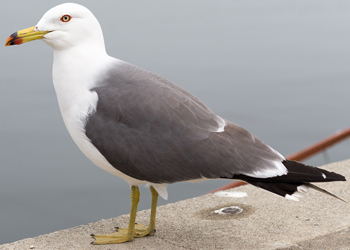 |
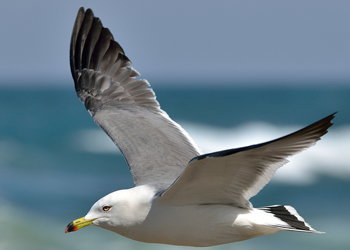 |
| Black-tailed Gull (crassirostris) adult, May 03 2015, Hachinohe-shi, Japan (GenJapan). Note bill pattern and yellow iris. |
Black-tailed Gull (crassirostris) adult, February 23 2014, Japan (淡水蛤). No or very restricted mirror on P10 in adult plumage. Of course: black tail. |
| CALIFORNIA GULL (w. N. America) is paler gray above (Kodak 5-7.5) with dark eyes, bold white tips and mirrors on outer primaries, and all-white tail. |
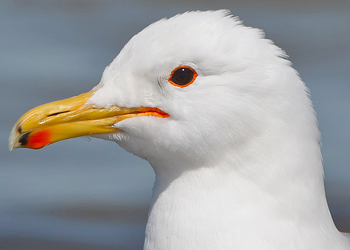 |
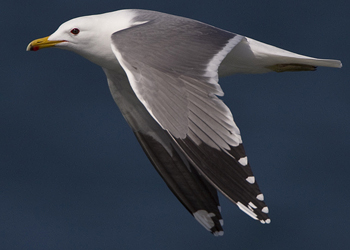 |
| California Gull (californicus) adult, May 13 2012, Alberta (Raymond Lee). Reddish orange orbital ring and dark iris. |
California Gull (californicus) adult, April 01 2010, Port Townsend, WA (Bob Whitney). Much black in wingtip, in combination with large mirrors. Red orbital ring and dark iris. |
| LESSER BLACK-BACKED GULL (widespread) larger with relatively shorter bill, wingtips have white mirrors on P10 or P9-P10 and tail all white. |
 |
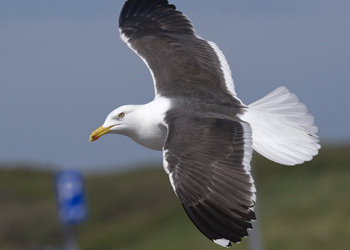 |
| Lesser Black-backed Gull (fuscus) 7CY (6th cycle), April 27 2013, Calais, NW France (Jean-Michel Sauvage). Graellsii type. Pullus 2007 at Calais, NW France. Note bill colour and shape |
Lesser Black-backed Gull (fuscus) adult, May 09 2014, Katwijk, the Netherlands (Mars Muusse). Graellsii type. All white tail. |
First Cycle.
Distinctive; note size and structure, bill length and pattern, and overall dark brown aspect with contrasting white tail coverts and black tail. |
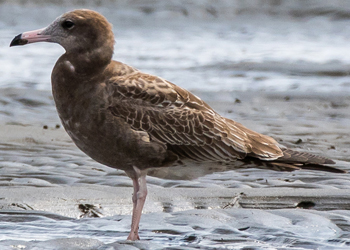 |
 |
| Black-tailed Gull (crassirostris) 1st cycle (1CY), September 15 2015, Tokyo, Japan (Yoshihiro Ogawa). Juvenile, with several upper scapulars replaced. |
Black-tailed Gull (crassirostris) 1st cycle (1CY), November 11 2014, Nagasaki, Japan (Nobuo Fukushima). 1st gen flight feathers. White uppertail coverts. |
| HEERMANN’S GULL (w. N. America) uniformly dark brown (lacking contrasting white tail coverts) with smaller bill (duller flesh basally) and black legs. |
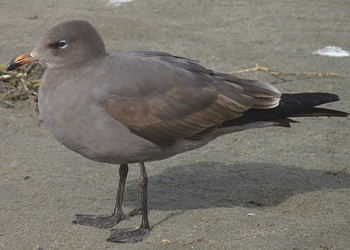 |
 |
| Heermann's Gull (heermanni) 2nd cycle (3CY), January 2010, Morro Bay, CA.(Amar Ayyash). |
Heermann's Gull (heermanni) 1st cycle (2CY), January 20 2014, San Francisco, CA. (Amar Ayyash). Overall dark brown aspect. |
| CALIFORNIA GULL has overall paler and grayer head and underparts, lacks white eye-crescents, often has more-variegated upperparts, tail coverts more heavily barred dark brown, and tail not solidly black. |
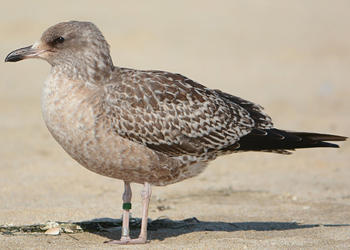 |
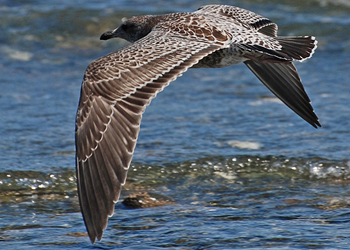 |
| California Gull (californicus) 1125-06236 1st cycle, September 12 2014, Half Moon Bay, CA. (Amar Ayyash). |
California Gull (californicus) 1st cycle, July 30 2010, Qualicum Beach, BC (Guy Monty). Juvenile, with dark inner primaries. |
Second Cycle.
Distinctive, although at this age it might be more easily confused with California Gull than at other ages; note long bill, white eye-crescents, black tail, tone of gray on upperparts, and upperwing pattern. |
 |
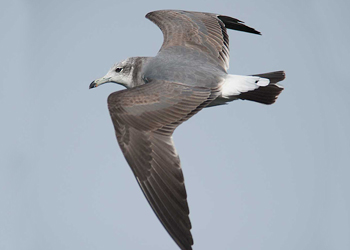 |
| Black-tailed Gull (crassirostris) 2nd cycle (3CY), February 24 2015, Nagasaki, Japan (Nobuo Fukushima). 2nd gen flight feathers, with white tips on rectrices. Red shimmering through on bill. |
Black-tailed Gull (crassirostris) 2nd cycle (2CY), November 30 2012, Nagasaki, Japan (Nobuo Fukushima). |
| CALIFORNIA GULL has relatively shorter bill that lacks red at tip, dusky markings on head and underparts (including wing-linings) are more mottled and streaky, less diffuse, gray on upperparts is paler, eyes are dark brown without white eye-crescents, and paler inner 3-4 primaries form contrasting panel on upperwing (uniformly dark on Black-tailed). |
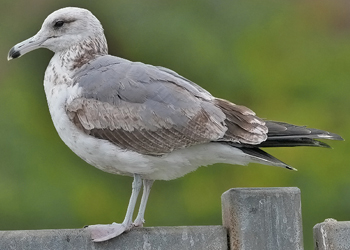 |

|
| California Gull (californicus, presumed ssp albertaensis) 2nd cycle (3CY), January 09 2005, Rio del Mar, CA. (Jeff Poklen). |
California Gull (californicus, presumed ssp albertaensis) 2nd cycle (2CY), November 09 2005, Venice Beach, Half Moon Bay, CA. (Jeff Poklen). |
Third Cycle. Third-cycle Black-tailed Gull looks much like adult, which see for differences from other species; some third-cycle Lesser Black-backed Gulls have black in the tail, but this does not form a neat, broad subterminal band.
END OF PART 1
CONTINUE PART 2 - RARER SPECIES |
 Black-tailed Gull (crassirostris) sub-adult, February 24 2015, Chidiwa Unzen city, Nagasaki, Japan. Picture: Nobuo Fukushima. Black-tailed Gull (crassirostris) sub-adult, February 24 2015, Chidiwa Unzen city, Nagasaki, Japan. Picture: Nobuo Fukushima. |
 Black-tailed Gull (crassirostris) / ウミネコ / 괭이갈매기
Black-tailed Gull (crassirostris) / ウミネコ / 괭이갈매기 This medium-sized four-cycle gull of ne. Asia is a vagrant to N. America, with records scattered from Alaska to Belize. Bill relatively long and parallel-edged with slight to moderate gonydeal expansion. At rest, tail tip falls at or slightly beyond tip of P6, so wing projection relatively long. Adult has slaty gray upperparts (Kodak 8-9.5) with black wingtips (lacking white mirrors), broad black subterminal tail band, and, in basic plumage, fairly diffuse dusky head and hindneck streaking. Juvenile dark brown overall with mostly blackish tail. PA1 variable, starting Sept.-Oct. Subsequent ages variable in appearance. First cycle has flesh pink legs becoming yellow by adult cycle; adult eyes pale lemon, orbital ring red.
This medium-sized four-cycle gull of ne. Asia is a vagrant to N. America, with records scattered from Alaska to Belize. Bill relatively long and parallel-edged with slight to moderate gonydeal expansion. At rest, tail tip falls at or slightly beyond tip of P6, so wing projection relatively long. Adult has slaty gray upperparts (Kodak 8-9.5) with black wingtips (lacking white mirrors), broad black subterminal tail band, and, in basic plumage, fairly diffuse dusky head and hindneck streaking. Juvenile dark brown overall with mostly blackish tail. PA1 variable, starting Sept.-Oct. Subsequent ages variable in appearance. First cycle has flesh pink legs becoming yellow by adult cycle; adult eyes pale lemon, orbital ring red.  Black-tailed Gull (crassirostris) sub-adult, February 24 2015, Chidiwa Unzen city, Nagasaki, Japan. Picture: Nobuo Fukushima.
Black-tailed Gull (crassirostris) sub-adult, February 24 2015, Chidiwa Unzen city, Nagasaki, Japan. Picture: Nobuo Fukushima. Black-tailed Gull (crassirostris) sub-adult, January 26 2007, Chidiwa Unzen city, Nagasaki, Japan. Picture: Nobuo Fukushima.
Black-tailed Gull (crassirostris) sub-adult, January 26 2007, Chidiwa Unzen city, Nagasaki, Japan. Picture: Nobuo Fukushima.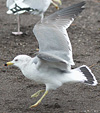 Black-tailed Gull (crassirostris) 3rd cycle (4CY), February 14 2016, Chidiwa Unzen city, Nagasaki, Japan. Picture: Nobuo Fukushima.
Black-tailed Gull (crassirostris) 3rd cycle (4CY), February 14 2016, Chidiwa Unzen city, Nagasaki, Japan. Picture: Nobuo Fukushima. Black-tailed Gull (crassirostris) sub-adult, February 04 2011, Off coast Nagasaki prefecture, Japan. Picture: John Wright.
Black-tailed Gull (crassirostris) sub-adult, February 04 2011, Off coast Nagasaki prefecture, Japan. Picture: John Wright.













